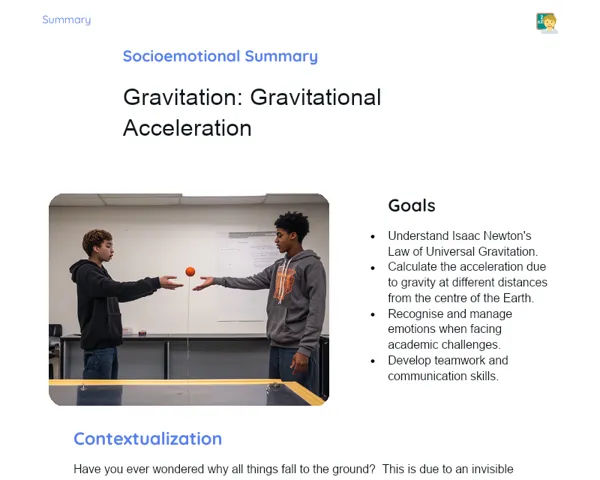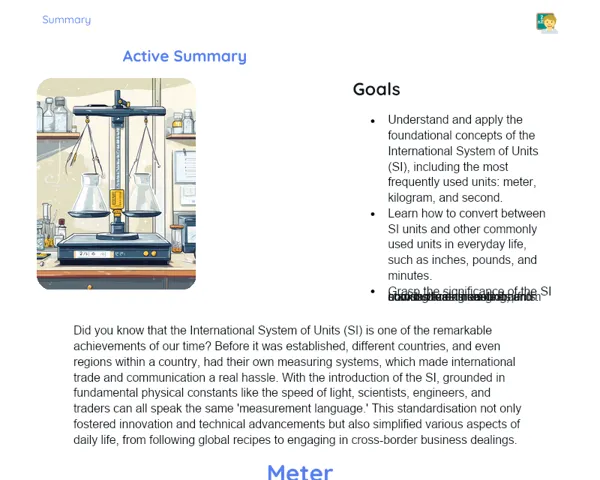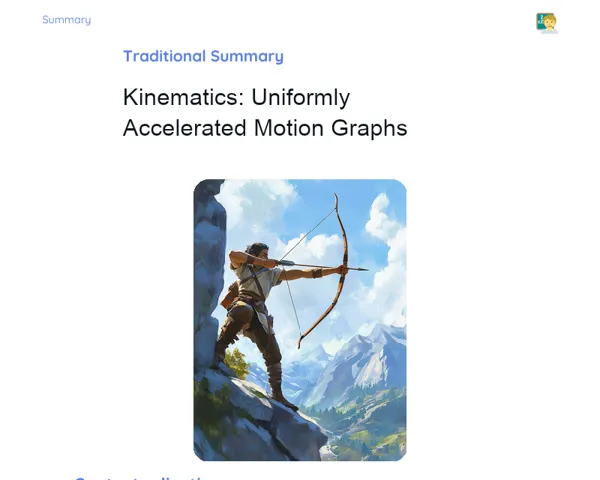Socioemotional Summary Conclusion
Goals
1. Grasp the concept of centripetal acceleration and its formula: a = v²/r.
2. Identify real-life situations where centripetal acceleration occurs.
3. Gain the ability to calculate centripetal acceleration across different contexts.
Contextualization
Ever wondered how a car manages to take a corner without skidding off the road or how those thrilling rides at the amusement park don’t send you flying off? These scenarios, among many others, are all tied to centripetal acceleration. Not only does understanding this concept help explain various everyday phenomena, but it also aids you in making safer choices!
Exercising Your Knowledge
Centripetal Acceleration
Centripetal acceleration refers to the acceleration that keeps an object moving in a circular path, always directed towards the centre of that circle. It's crucial for understanding how objects in circular motion, like cars navigating curves or satellites orbiting the earth, maintain their paths.
-
Constant Direction: Centripetal acceleration constantly points towards the centre of the circle, ensuring the object stays on its circular path.
-
Dependence on Speed and Radius: The formula a = v² / r indicates that centripetal acceleration depends directly on the square of the velocity and inversely on the radius. This implies that increasing speed has a more pronounced effect than changing the radius of the path.
-
Measurement Unit: Centripetal acceleration is measured in metres per second squared (m/s²). Knowing these units is vital for accurate calculations.
-
Apparent Centrifugal Force: While not a 'real' force, centrifugal force is that feeling of being pushed outward during a turn, a sensation often experienced in cars and amusement park rides.
Centripetal Force
Centripetal force is the force acting on an object in circular motion that pulls it towards the centre of the circle. It can arise from various sources like the tension in a rope, gravity, or friction.
-
Nature of the Force: It can be generated by different forces, such as the pull from a rope, the friction between the tyres of a car and the road, or the gravitational force exerted by celestial bodies.
-
Essential Role: Without centripetal force, an object in circular motion would drift off in a straight line instead of maintaining its circular path.
-
Everyday Examples: Centripetal force plays a key role in our daily experiences, from amusement park rides to cars taking turns, and even in the movements of planets in space.
Everyday Context of Centripetal Acceleration
Linking centripetal acceleration to everyday scenarios makes the concept more relatable. We can apply this understanding to common situations like driving around corners or the orbit of satellites.
-
Car Taking Turns: Familiarity with centripetal acceleration aids in assessing the safety of turns, considering speed and curve radius to prevent mishaps.
-
Amusement Park Rides: Grasping this concept can boost feelings of safety and confidence when enjoying high-speed rides.
-
Satellite Orbits: Understanding centripetal acceleration and the related centripetal force clarifies how satellites stay in orbit rather than plummeting back to earth.
Key Terms
-
Centripetal Acceleration: The acceleration acting on an object moving in a circle, directed towards the circle's centre.
-
Centripetal Force: The force that keeps an object moving in a circle, which can come from tension, friction, gravity, etc.
-
Linear Velocity: The speed along the tangential path in circular motion.
-
Radius of the Path: The distance from the centre of the circular path to the object in motion.
For Reflection
-
How can you use the concept of centripetal acceleration to enhance your safety while driving?
-
What emotions do you feel when you experience fast circular movements, such as on amusement park rides, and how can you manage those feelings?
-
How could a better understanding of centripetal acceleration help you tackle problems in both physics and day-to-day life?
Important Conclusions
-
Centripetal acceleration is vital for understanding circular motion and appears in various aspects of our daily lives, like cars taking turns and satellites in orbit.
-
The formula a = v²/r enables us to calculate centripetal acceleration, highlighting how speed and the radius impact this movement.
-
Grasping centripetal acceleration equips us to make safer, well-informed choices in our daily activities while also honing critical thinking and problem-solving skills.
Impacts on Society
Understanding centripetal acceleration plays a crucial role in our society, particularly regarding driving safety. Knowing how acceleration affects vehicles is essential for preventing accidents on bends and improving car design. When we learn about centripetal acceleration, we can adjust our speed and trajectory to ensure safer and more efficient driving.
Additionally, this knowledge is fundamental in industries like aerospace and satellite technology. Centripetal acceleration is key to maintaining satellites in stable orbits, affecting services like telecommunications, GPS, and many others. By delving into centripetal acceleration, we also foster a deeper appreciation of the marvels of science and technology that shape our modern world.
Dealing with Emotions
🌟 Take a moment to reflect on how your understanding of centripetal acceleration has affected your view of safety while driving or when enjoying yourself at amusement parks. Use the RULER method to explore your emotions:
- Recognise the feelings you experienced while learning about the topic.
- Understand what caused those feelings.
- Name those emotions accurately.
- Express your emotions appropriately, whether by chatting with friends or jotting down thoughts in a journal.
- Regulate those emotions by finding strategies that resonate with you, like mindfulness or breathing exercises.
This exercise not only aids in managing complex emotions but also allows you to apply your knowledge in a thoughtful and responsible way!
Study Tips
-
📖 Practice extra exercises calculating centripetal acceleration. The more you engage with the material, the more confidence you'll gain!
-
🎢 Relate the content to everyday experiences, such as observing rides at amusement parks or analysing the motion of cars on curves for relevance.
-
📣 Discuss your learnings with classmates or family members. Explaining concepts to others is a fantastic way to reinforce your understanding!



